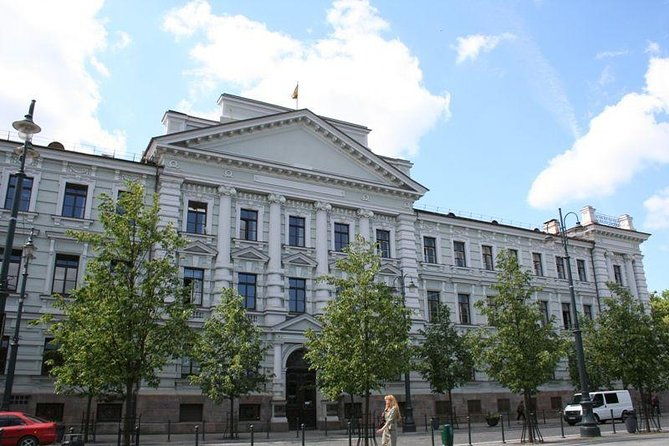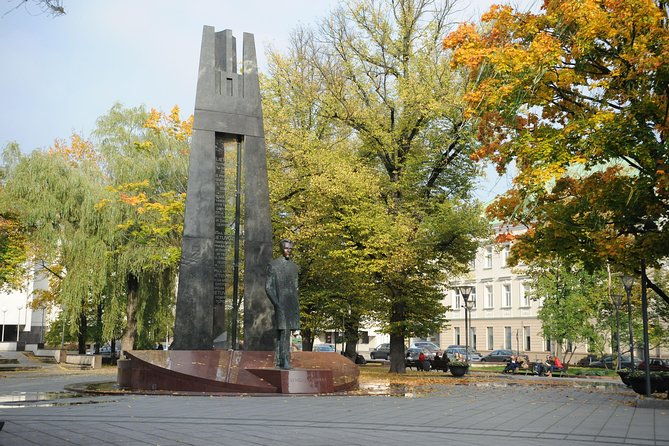Vilnius, Lithuania’s capital, bears the scars of a long and arduous journey to freedom. Though the Soviet occupation left its mark, the city’s historic sites tell a tale of resilience. From the KGB Museum to the Museum of Occupations, visitors can glimpse the Lithuanian spirit’s unwavering determination to preserve its heritage. As the nation celebrates its independence and EU integration, Vilnius invites travelers to uncover the remarkable story behind its transformation.
Key Points

-
The Soviet occupation of Lithuania for over 50 years shaped its history, leaving deep scars and spurring a persistent spirit of resistance.
-
The declaration of independence in 1990 marked a critical milestone in Lithuania’s struggle for self-governance, despite facing threats and economic blockades from Moscow.
-
The KGB Museum and Museum of Occupations in Vilnius provide haunting insights into the persecution, repression, and brutality experienced under Soviet and Nazi rule.
-
Lithuania’s membership in the Council of Europe in 1994 and the European Union in 2004 solidified its status as a free nation, offering economic, political, and social benefits.
-
The journey to independence and integration into the European community is central to Lithuania’s modern identity, reflecting its resilience and determination to preserve its national heritage.
Historical Overview of Lithuania

While Lithuania’s history spans centuries, the 20th century saw the country’s transition from occupation to independence and inclusion in the European Union.
The nation endured 50 years of Soviet rule, during which it fought for autonomy and cultural preservation. This tumultuous period culminated in Lithuania’s declaration of independence in 1990, marking a new era of self-governance.
Today, Lithuania’s membership in the EU represents a hard-won victory, symbolizing its integration into the broader European community after decades of oppression.
Lithuania’s EU membership signifies its hard-fought integration into the broader European community after decades of oppression.
Understanding this complex history is central to appreciating Lithuania’s modern identity and resilience.
Fascinated by the past? Here are other historical experiences we've covered in Vilnius
The Soviet Occupation and Its Impact

The Soviet occupation of Lithuania cast a long shadow over the country, profoundly shaping its history and identity.
For five decades, the Lithuanian people suffered under an oppressive regime that sought to erase their national heritage and integrate them into the Soviet Union. The KGB’s brutal crackdown on dissent, the forced Russification of schools and institutions, and the deportation of countless Lithuanians to Siberian gulags left deep scars.
Yet, the spirit of resistance never waned. This history of struggle and resilience is a central focus of the Vilnius tour, offering insights into Lithuania’s hard-won journey towards independence and European integration.
Lithuania’s Road to Independence
After decades of Soviet occupation, the Lithuanian people never lost their determination to regain their independence. In 1990, Lithuania became the first Soviet republic to declare independence, sparking a tense standoff with Moscow. Despite threats and economic blockades, the Lithuanian government held firm, eventually gaining international recognition. The path to freedom was not easy, but the people’s resolve was unbreakable.
| Year | Event |
| — | — |
| 1990 | Lithuania declares independence |
| 1991 | Lithuania recognized by the Soviet Union |
| 1994 | Lithuania joins the Council of Europe |
This hard-won independence paved the way for Lithuania’s integration into the European Union in 2004, cementing its place as a free and sovereign nation.
The Struggle for Freedom
Lithuania’s hard-won independence was just the beginning of a new chapter in the country’s history. The struggle for freedom continued as Lithuania navigated the challenges of rebuilding a nation.
This involved:
-
Establishing democratic institutions and the rule of law.
-
Transitioning to a market economy and integrating with European structures.
-
Preserving and promoting Lithuania’s cultural identity.
The path wasn’t easy, but the Lithuanian people remained steadfast in their pursuit of a brighter future.
With resilience and determination, they overcame obstacles and solidified their place as a free and prosperous European nation.
The KGB Museum: a Window Into the Past
As a poignant reminder of Lithuania’s history under Soviet occupation, the KGB Museum offers visitors a window into the past.
Housed in the former KGB headquarters, the museum chronicles the persecution and repression endured by the Lithuanian people. Visitors can explore the haunting interrogation rooms, see the holding cells, and learn about the tactics used by the secret police.
The museum’s exhibits provide a sobering yet essential perspective on the country’s long struggle for independence. Through this powerful experience, travelers gain a deeper understanding of Lithuania’s resilience in the face of authoritarian rule and its remarkable journey to freedom.
Exploring the Museum of Occupations and Freedom Fights
Continuing the exploration of Lithuania’s complex history, the Museum of Occupations and Freedom Fights offers visitors a profound look at the nation’s struggle for independence.
The museum’s exhibits chronicle Lithuania’s experience under Soviet and Nazi occupation, highlighting:
-
The brutality of the KGB, whose atrocities are powerfully depicted through multimedia displays.
-
The defiant acts of Lithuanian resistance fighters who fought for their country’s freedom.
-
The eventual restoration of Lithuania’s independence and its path to joining the European Union.
This somber yet impactful museum provides a poignant reminder of the high price paid for liberty.
The Significance of Lithuania’s EU Inclusion
Though Lithuania’s inclusion in the European Union marked a momentous milestone in the nation’s history, it was more than just a symbolic achievement. It signified the country’s hard-fought journey to reclaim its rightful place in the European community after decades of Soviet occupation.
| Key Benefits | Significance |
| — | — |
| Economic Integration | Access to EU markets, funding, and trade agreements |
| Political Influence | Stronger voice in European decision-making |
| Security Assurance | Membership in NATO and EU defense mechanisms |
| Social Connections | Freedom of movement and cultural exchange |
This milestone cemented Lithuania’s transition to a modern, democratic state and solidified its ties with the West, paving the way for a brighter future.
Discovering Vilnius’ Rich Cultural Heritage
Vilnius, the captivating capital of Lithuania, beckons visitors to enjoy its rich cultural heritage.
From the awe-inspiring architecture of the Old Town to the poignant reminders of the nation’s tumultuous past, Vilnius offers a tapestry of experiences that captivate the senses.
Explore the:
-
Stunning Cathedral Square, where the iconic cathedral and belfry stand as testaments to Lithuania’s Christian legacy.
-
KGB Museum, a sobering exploration of the Soviet occupation and the resilience of the Lithuanian people.
-
Museum of Occupations and Freedom Fights, which chronicles the nation’s long struggle for independence.
Immersing oneself in Vilnius’ cultural treasures provides a profound understanding of Lithuania’s journey to freedom.
Frequently Asked Questions
What Is the Dress Code for the Tour?
There’s no formal dress code for the tour. Wear comfortable walking shoes and clothing suitable for the weather, as the tour involves exploring outdoor historical sites around Vilnius.
Can I Bring My Own Food and Drinks?
The tour doesn’t mention any restrictions on bringing your own food and drinks. You’re free to bring whatever snacks or beverages you’d like to enjoy during the walking tour of Vilnius’ historical sites.
Is There a Limit on the Number of Participants?
Yes, the tour has a small group size limit of 15 or fewer participants. This allows for a more intimate and personalized experience as you explore the historical sights and insights with your knowledgeable guide.
Do I Need to Purchase Tickets for the Museums in Advance?
No, tickets for the museums don’t need to be purchased in advance. The tour includes admission to the KGB Museum, which is available Wednesday to Sunday. The guide will handle the logistics and entry for the group.
Can I Extend the Tour Duration if Needed?
Yes, you can extend the tour duration if needed. The tour provider offers flexibility, and you can discuss extending the experience with your knowledgeable guide to accommodate your interests and schedule.
The Sum Up
Vilnius’ historical landmarks symbolize Lithuania’s long and arduous journey to freedom. The KGB Museum and Museum of Occupations vividly illustrate the nation’s resilience against oppression. The declaration of independence in 1990 and Lithuania’s EU integration represent a new era of self-governance and a profound commitment to preserving its rich cultural heritage. Vilnius’ past paves the way for a future of continued growth and independence.
More Private Tours in Vilnius
More Boat Tours & Cruises in Vilnius
More Tour Reviews in Vilnius
Still browsing? Here are more Vilnius experiences we've covered recently
- 13 Most Highly Rated Tours In Vilnius
- 12 Of The Best Walking Tours In Vilnius
- We Rank Vilnius’s 5 Top Full-Day Tours
- 6 Of The Best Private Driver Services In Vilnius
- What Are The Best Tours & Experiences In Vilnius? Our Top 14 Picks
- The Top 5 City Tours In Vilnius
- 3 Of The Best National Park Tours In Vilnius
- Vilnius’s 6 Best Drinking Tours (With Prices & Reviews)
- 8 Top Bike Tours In Vilnius (With Reviews & Prices)
- Vilnius: The Way of Freedom: Behind the Walls of the KGB
- Hill of Crosses and Siauliai Tour
- Vilnius: Private Ghostly Tales Walking Tour
